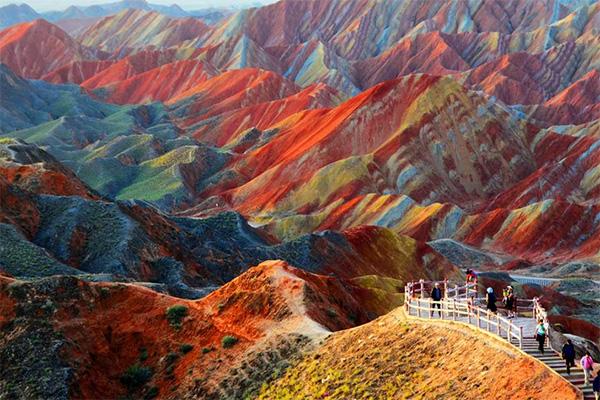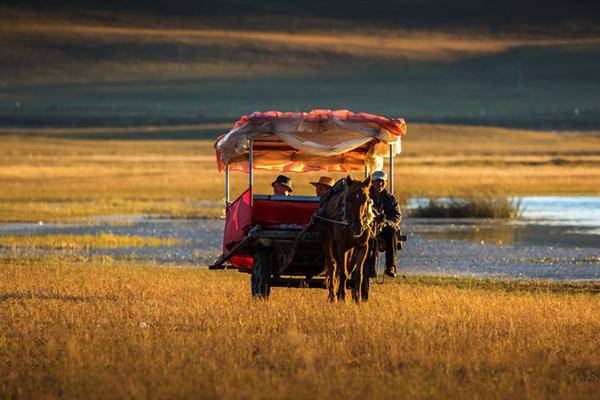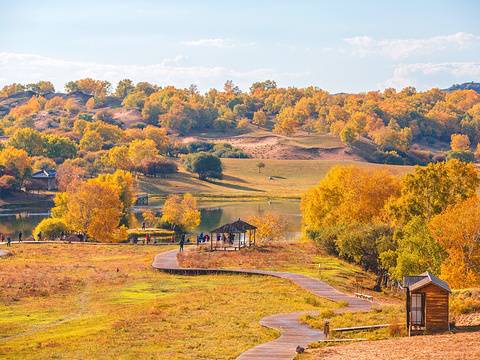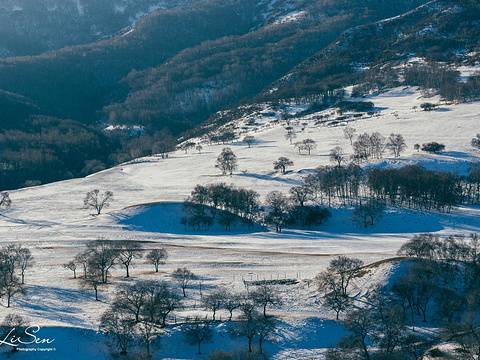General Paozi is located within Saihanba. The water surface here is wide and surrounded by mountains. Every day around six o'clock, a large group of horses rush to the lake to drink water. The sight of the horses entering the water and the splashing water is very beautiful. As night falls, you can stay overnight in a yurt by the lake, sit around a bonfire, and enjoy the mournful and melodious sounds of the horsehead fiddle and the solemn and poignant Mongolian long tune, creating a unique atmosphere.
Ulan Butong Tourist Area - Princess Lake
Princess Lake is located more than 20 kilometers northwest of Hongshan Army Horse Farm, north of Saihanba. By the lunar calendar's September, winter has already arrived on the plateau, with temperatures dropping to minus seven or eight degrees Celsius. There are no more flowers or green grass, and the leaves of the birch trees have fallen, making the vast grassland appear desolate. However, Princess Lake remains beautiful as ever. In the morning light, Princess Lake is enchanting and mesmerizing. The name 'Princess Lake' is said to originate from a legend where the third princess of Emperor Kangxi, Lanqi Gege, was forced to marry Galdan and cried so much that her tears formed the lake. The lake in Hexigten Banner is thus called Princess Lake.
Hama Ba
Hama Ba is located within the Ulan Butong region of Keshiketeng Banner, at the border of Hebei and Inner Mongolia. It is a high, gentle slope with three sides bordered by valleys or lowlands. The area is characterized by hilly terrain and unique landforms. In autumn, the scenery is vibrant and colorful, with hills covered in red leaves and golden birch leaves blending together to create natural paintings. For photographers, this is a treasured spot for endless and ever-refreshing photographic creations. Hama Ba is a high, gentle slope with three sides bordered by valleys or lowlands. The area is characterized by hilly terrain, and in autumn, the scenery is vibrant and colorful, with hills covered in red leaves. For photographers, this is a treasured spot for endless and ever-refreshing photographic creations.
Ulan Butong Film Base
Ulan Butong Grassland is famous because Emperor Kangxi of the Qing Dynasty once defeated Galdan here. The Battle of Ulan Butong in the early Qing Dynasty stabilized the northern border of the country and laid the foundation for the unification of the Qing Dynasty. The scenery here is picturesque, with vast grasslands, rolling mountains, winding rivers, dense forests, and ancient battlefield relics such as General Paozi. According to incomplete statistics, over the past 10 years, more than 60 films and TV dramas have been shot here. Therefore, Ulan Butong is also a well-known film shooting base both at home and abroad, and is known as the 'Grassland Film City'. The film industry refers to this place as an open-air studio. Every time a film or TV drama is shot here, a stone tablet is placed on the grassland. Many tourists gather around the stone tablets, counting the names of the films and TV dramas and taking photos as souvenirs.
Hongshan Military Horse Farm
Hongshan Military Horse Farm boasts beautiful scenery and unique landscapes. It is an important scenic spot within the Mulan Weichang, often praised for its European-like beauty. Besides the stunning views, visitors can ride horses across the grasslands, explore ancient battle relics, join joyful bonfire parties, and savor authentic roasted whole lamb.
Wucai Mountain
Wucai Mountain is one of the main attractions for viewing the autumn scenery of secondary forests in the Machang jurisdiction. Originally named Yujia Mountain, 'Wucai' (meaning 'multicolored') is a figurative term, as the mountain displays far more than just five colors. From late September to early October each year, due to the effects of light frost, different tree species on the mountain exhibit various colors based on their cold resistance. Wucai Mountain appears to be adorned in festive attire, with the green of pines, the red of oaks, the purple of apricots, the yellow and white of birches and poplars, and many other colors competing for attention. The vibrant display of colors, from crimson to yellow, green, blue, and purple, truly makes it a sight to behold. The phrase 'the mountains are covered in red, and the forests are dyed in layers' perfectly describes this breathtaking scene.















